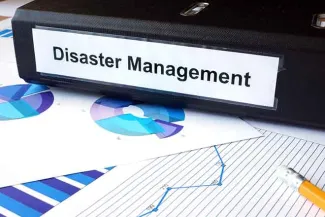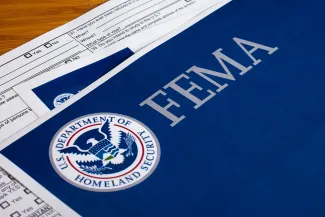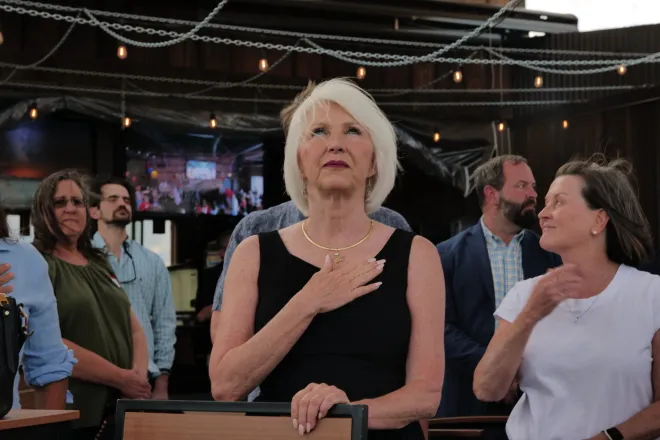
Uncertainty about federal disaster aid looms as storms roll in
© JJ Gouin - iStock-1642293566
When a severe tornado tore through Cave City, Arkansas, in March, retiree Debra Lindsey was in her trailer home with her husband.
“I didn’t even know there was a tornado on the ground until the sirens went off, and then in 45 seconds it was here,” Lindsey said. “It was very scary. If it would’ve been 100 to 150 feet closer to here, it would’ve taken the front of our trailer off.”
Even without a direct hit, she estimated that the damage to their home and property was between $30,000 and $40,000. Their storage buildings were destroyed, along with their two vehicles. And the insurance company won’t cover everything.

© iStock - ArtemSam
Across the street, Robert and Kymberlie Watson rode out the tornadoes with their seven children in the nearest storm shelter. When they returned, they found roughly $60,000 worth of damage to their property.
About one month after the tornadoes, the Trump administration denied Arkansas’ request for a major disaster declaration. The declaration would have brought federal funds into the state to help with recovery. Both families thought they’d have to pay out-of-pocket for repairs.
The power to grant a disaster declaration and access to the Federal Emergency Management Agency’s assistance programs lies solely in the hands of the president, and President Donald Trump’s administration is looking to significantly scale back FEMA and pass disaster recovery costs onto states.
Lindsey, a disabled retired nurse, feared that the lack of federal assistance for their home repairs would force her back into the workforce.
Another round of severe weather walloped the Lower Mississippi River Basin in early April, causing extensive flooding and more tornado damage in parts of Arkansas, Tennessee, Kentucky and Mississippi.
Then, some good news: The Trump administration reversed course on May 13 after an appeal and a personal plea from Arkansas Republican Governor Sarah Huckabee Sanders. The president granted a major disaster declaration, allowing individuals like Lindsey and the Watsons to apply for aid.
“If we get some help out of it, that’s absolutely amazing. We could really use it,” Kymberlie Watson said. “We’re surprised, a little bit … because the government actually stepped up and helped its citizens.”
Cave City may not be so lucky. Trump has yet to approve recovery assistance to public entities, which may leave local governments — including the town of less than 2,000 residents — with big bills. On May 3, Sanders submitted another disaster declaration application asking for extensive public assistance. Requests for FEMA aid from Mississippi, Missouri and Tennessee also remain outstanding, though the Trump administration did grant Kentucky’s request.
“President Trump and his administration will continue working to further empower state and local governments to build their own resilience before disaster strikes and to execute rapid, smart response when supplemental federal assistance is required to truly protect citizens and aid a return to normalcy,” a White House official wrote the Desk by email.
Cave City pushes forward
Cave City Mayor Jonas Anderson was at a ribbon-cutting event for the city’s ambulance service when he learned of the initial rejection from the Trump administration. His first thought?
“You have got to be kidding me,” he said.
Anderson estimated that some 50 Cave City homes were damaged in the March tornado, and 25 of those were completely destroyed. He said underinsurance was likely a huge issue in the community, and the costs for the city to remove all the debris might run over $300,000 for a municipality that only has an annual budget of around $1.4 million. Cave City also lost its only grocery store, forcing residents to drive 20 to 30 minutes to nearby towns for necessities.

© iStock - designer491
A disaster declaration opens up potential programs for state and local governments to recoup some money spent on removing debris and repairing infrastructure. It can also unlock assistance programs for individuals, including post-disaster support services and financial aid for people who are uninsured or underinsured. Not all programs are offered for every disaster.
After a disaster, government personnel assess the cost of damage. Sanders’ requests for federal disaster aid for dozens of counties mostly in the Arkansas Delta estimated public damages at over $21 million from both the March and April storms, including more than $3 million in Sharp County, home to part of Cave City.
FEMA uses cost per capita to gauge whether local and state governments can handle recovery themselves, or if they’ll need federal help. Those indicators currently stand at $4.72 per capita for counties and $1.89 per capita for states. Per capita damages for Sharp County, where Cave City is located, are estimated at $179.
But meeting those indicators does not guarantee that the president will approve a disaster declaration. A president is not required to justify their decision, and documentation of the reasons for denial is considered privileged — not public record.
Sanders released a statement thanking the Trump administration for finally delivering individual assistance, but did not mention her second, outstanding request for public assistance and additional funds. She also expressed support for Trump’s efforts to reform FEMA.
“Our entire state is grateful for President Trump’s leadership and assistance as we recover from the devastating storms that struck Arkansas earlier this spring,” Sanders said. “I had a productive conversation with the President in which he expressed his support for our state and I offered my full endorsement of his plans to reform FEMA to save money and provide greater direct assistance to disaster victims.”
FEMA politics
Over the past two years, the Biden administration provided more than $101 million in public disaster recovery funding to Arkansas, according to FEMA data. And before that, the first Trump administration gave Arkansas more than $101 million in federal disaster recovery assistance between 2017 and 2020.
States in the Lower Mississippi River Basin have received more than $31.3 billion in federal public recovery assistance following natural disasters since 1998, according to FEMA data. Hurricane response has consistently required the most federal assistance.
In recent years, there have been more requests for disaster declarations and more of them have been approved than denied. Between 1953 and 1999, Lower Mississippi River Basin states saw two approvals for every one denial. Within the last 25 years, the approval ratio rose to 5-1.

© danielfela - iStock-483743566
John Gasper, an associate professor of economics at Carnegie Mellon University’s Tepper School of Business, found in a 2015 analysis of county-level FEMA data from 1992 through 2005 that the chance of a denial is lower when the president and governor belong to the same political party. In “non-election years or non-opportune times,” denials typically follow FEMA’s unofficial guidelines, he said in a May interview.
There are two reasons for FEMA aid’s president-centric policy design, Gasper said: The federal government wants the ability to grant aid in “marginal cases that don’t make the indicator but still are clear disasters,” and politicians realize the benefits of giving aid to constituents.
“In an election year, it’s a great opportunity for a campaigning official to come in, do photo-ops, roll up their sleeves, etcetera,” he said. “In non-election years, they have less concern there, so the probability of denial goes up substantially.”
The denial of Arkansas’ initial request for help was “shocking,” said Anderson. Sanders, who worked as press secretary for Trump for part of his first term, credited her access to the president for her appeal’s eventual success.
Changes at FEMA have further muddied the process of requesting and obtaining disaster assistance. Since January, the Trump administration has dismissed hundreds of FEMA employees and scrapped an agency program funding disaster prevention efforts in states and municipalities. The Building Resilient Infrastructure and Communities program had made $5 billion in grant money available since 2020, awarding over $12 million to Arkansas, Mississippi and Tennessee through 2023.
Federal officials have also discussed making it harder to secure funds after a disaster. In an internal memo obtained by CNN, former acting FEMA Administrator Cameron Hamilton proposed various reforms to curb the agency’s disaster spending, including quadrupling the financial burden states must sustain to qualify for public aid. Hamilton was fired weeks later, and state officials say they have received no word regarding changes to FEMA’s public assistance indicator.
While the higher benchmark proposed by Hamilton has not been adopted publicly, the low number of disaster declarations approved so far this year suggests the White House is following new standards for public aid eligibility, one emergency management expert explained.

“We don’t have to wait for an official guidance on this. We know that the bar has shifted,” said Bryan Koon, who led Florida’s Division of Emergency Management from 2011 to 2017 and is CEO of IEM, a disaster management consulting firm. “What got you a declaration in 2024 and earlier is not going to get you a disaster declaration in 2025.”
Hamilton’s replacement at FEMA, David Richardson, reportedly held a meeting with staff where he said a large part of the response and recovery would be put on states under his leadership, according to Drop Site News.
Bipartisan support for disaster aid reform does exist, but Trump’s FEMA overhaul has sparked concern among state emergency management officials, who say they aren’t prepared to take over disaster funding responsibilities from the agency.
Such a transition would require extensive guidance from the administration and planning from state and local governments, said Lynn Budd, president of the National Emergency Management Association and director of Wyoming’s Office of Homeland Security. Reducing FEMA assistance with little clarity or advance notice risks leaving communities unprepared for disasters moving forward, she added.
Even with clearer messaging from the administration, scaling back FEMA support would require states to make tough choices on how to cover disaster costs and budget for future emergencies, Koon explained. Reallocating funds toward disaster management would mean cuts to other services, and states would have to lean heavily on volunteer organizations to fill financial and staffing gaps.
“States are going to have to adapt,” Koon said. “It’s going to be a lot more of a patchwork of support to make up for what would have come from the federal government.”

© iStock - gustovofrazao
Koon emphasized that shifting disaster expenses to states would also mean higher costs for residents. Households will have to purchase broader insurance coverage in the absence of FEMA assistance, he explained, and families will have to pay for damage previously covered by the agency.
In Mississippi, where residents are still recovering from the same storms and tornadoes that struck Arkansas in mid-March, emergency management officials said they will continue looking to FEMA for disaster assistance until they are instructed otherwise. The state is awaiting a decision from the White House on its own disaster declaration request, and officials said they won’t adjust operations or request additional funding from the legislature without more guidance from the administration.
“We have received no indication from FEMA about any proposed changes to formulas that determine federal disaster assistance,” said Scott Simmons, director of external affairs at the Mississippi Emergency Management Agency. “Until the rules of the game change, we’re going to continue playing by the rules.”
Others are looking ahead at how states could respond if FEMA steps back.
States already play active roles in recovery but they “need to become a little bit more proficient and get help in coordinating and answering disasters together,” Colin Wellenkamp, executive director of the Mississippi River Cities and Towns Initiative, a coalition of more than 100 mayors of river basin cities, said in early April following severe flooding along the river.
Flooding on the Mississippi River typically impacts all of its 10 bordering states, he said, so if states do take on more responsibility, they would need to work “in tandem” to coordinate recovery efforts.
“That isn’t necessarily something that happens through the FEMA process,” Wellenkamp said.
A new round of storms and tornadoes swept through the basin in mid-May, leaving major damage in St. Louis. And hurricane season begins June 1. Researchers are predicting above average activity this year.
With the Trump administration’s new approach to FEMA aid, Anderson worries that recovery for small places like Cave City may become even harder.
“There’s just things the Federal government has been or should be doing … they’re just a lot more equipped to handle that than a city or a state,”Anderson said. It’s an imperfect process and he added that “numbers on a spreadsheet don’t always tell the human story.”
This story is a product of the Mississippi River Basin Ag & Water Desk, an independent reporting network based at the University of Missouri in partnership with Report for America, with major funding from the Walton Family Foundation. Tennessee Lookout is part of States Newsroom, a national nonprofit news organization.

















